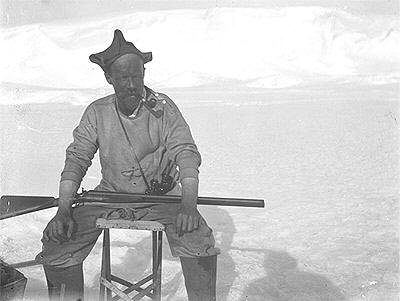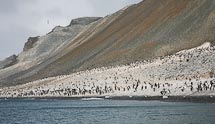 |
| Hurley and Shackleton at Ocean Camp |
The crew was beginning to settle in on the floe which would later be named
Ocean Camp. The crew spent the days exercising the dog teams or hunting seals. Food was not a problem because summer was approaching and the seals were beginning to come back south. The men found various methods to killing the seals such as shooting, bludgeoning, or severing the jugular. On November 21, the
Endurance, which had been abandoned three weeks prior, finally sank. The ship sank in ten short minutes and the crew was left in a place on Antarctica where no other man had been before.
Shackleton took the loss of the
Endurance the worst. The crew still had a surprising sense of optimism, and Shackleton sanctioned a special dinner for the crew the next night. The crew had drifted almost eighty miles north on the ice, and they were preparing to launch the three boats in an effort to make it to land. Hopefully the crew would be able to do this before winter arrived again. They calculated that Paulet Island was 200 miles from their position and with a favorable wind they may be able to make it there by the end of March. Shackleton ordered that the men eat as much of the food stores that they could before they pushed off the next morning because the stores would be left behind. At this point in the story, the
plot really begins to thicken. Not a single member on the crew knew what to expect after they left
Ocean Camp. The crew reached a new floe after cutting through a high-pressure ridge. The crew traveled two and a half miles in melting snow that reached as high as their knees. The crew's shoes became soak with water. When the boots became wet, they could weigh a little over seven pounds.This grueling journey all became futile when Shackleton's fear became a reality. The ice to the north stretched for at least another two miles and seemed virtually impassible. Going back to
Ocean Camp was out of the question because the floe's size was rapidly decreasing. "But what disturbed them the most was that they were trapped where they were." This sentence that Lansing wrote provides a fearful picture of what the men were thinking. Conditions on this floe were considerably worse. They had to move their camp two more times because of cracks in the ice. They retreated a little over a quarter mile to the center of a fairly solid floe. They settled in for the New Year, but they seemed to be completely trapped.
I can relate to the crew's futile efforts because I have tried so hard on some things that just turned out to be pointless. For example, last year towards the end of my cross country season I got pneumonia. I had worked intently in the months prior in order to perform well at the end of the season, but it all became a waste when I was unable to run due to my illness.

















